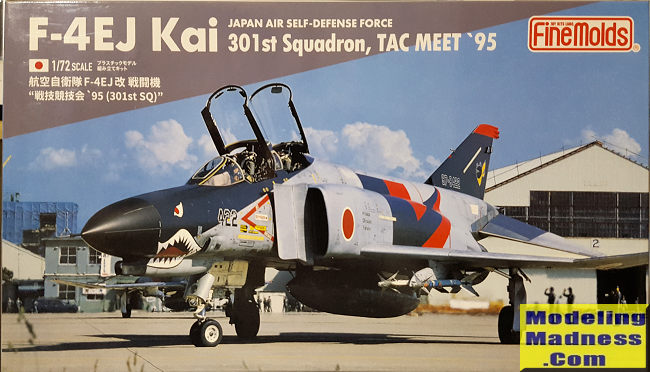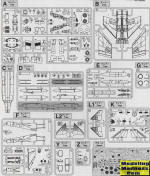
Fine Molds 1/72 F-4EJkai 301st Squadron -TAC Meet '95
| KIT #: | 72738 |
| PRICE: | 3900 yen SRP |
| DECALS: | Three options |
| REVIEWER: | Scott Van Aken |
| NOTES: | 2022 release |

| HISTORY |
The McDonnell Douglas F-4 Phantom II is an American tandem two-seat, twin-engine, all-weather, long-range supersonic jet interceptor and fighter-bomber originally developed by McDonnell Aircraft for the United States Navy. Proving highly adaptable, it entered service with the Navy in 1961 before it was adopted by the United States Marine Corps and the United States Air Force, and by the mid-1960s it had become a major part of their air arms. Phantom production ran from 1958 to 1981 with a total of 5,195 aircraft built, making it the most produced American supersonic military aircraft in history, and cementing its position as a signature combat aircraft of the Cold War.
The success of the Navy's F-4B and the delays in getting the F-111A into service led the USAF to order the F-4C (originally the F-110A) into production. The aircraft was quite successful leading to the similar F-4D and to the most built variant, the F-4E. This latter aircraft had upgraded avionics and engines, but most of all, was fitted with an internal M61 Vulcan rotary canon. It was this version that also saw fairly widespread foreign use with the type being built by Mitsubishi in Japan. These were some of the longest serving F-4s being finally retired in 2021, though some are still being used as test aircraft.
| THE KIT |
 Fine Molds has turned their expertise to the F-4
Phantom II. Initial releases were of the Japanese F-4EJ of which this is the
upgraded F-4EJkai it is quite welcome. Now this isn't the only F-4E by far as the type has
been previously kitted by Fujimi and Hasegawa just to name a couple. Those kits are still available and still make nice models. However,
this one has raised the bar in terms of engineering if nothing else.
Fine Molds has turned their expertise to the F-4
Phantom II. Initial releases were of the Japanese F-4EJ of which this is the
upgraded F-4EJkai it is quite welcome. Now this isn't the only F-4E by far as the type has
been previously kitted by Fujimi and Hasegawa just to name a couple. Those kits are still available and still make nice models. However,
this one has raised the bar in terms of engineering if nothing else.
Here are some of the interesting features. In the cockpit, the side consoles are separate inserts to take into account the various differences between variants. There is full intake trunking back to the first compressor stages. Not surprising is that the forward fuselage is separate. The main fuselage is a single piece with an upper deck insert so no worries about seams. There is also a detail piece for the engine aux intake doors.
Wings are a lower section that includes most of the lower fuselage with upper halves and separate wing tips. There is no folding wing option with this kit. This kit has the 'hard wing' as Japan never did the conversion to add slats as did the USAF. The wing underside has inserts for where the cat attachment points would be on the naval versions.
The metal portion of the rear fuselage is a separate item with an insert for the very aft portion. Again, to eliminate some of the usual seams one sees in other kits. You are provided only the fin that is appropriate to the EJkai version. Horizontal stabs are interlocking to help with alignment. Two sets are provided with one having the arrowhead shaped reinforcements. Both are slotted.
Inner main gear doors include a portion of the gear well so attaching these will be a breeze. You are provided missile pylons and three drop tanks. However, there are no weapons, those being offered in a separate weapons pack. Finally, you can do canopy open or closed with a separate closed canopy piece.
 Instructions
are in booklet form and are excellent, providing Gunze and FS 595 color
references. Three options are provided, all of which look similar but there are
differences. For instance, two of them are FS 32360 over FS 36375, while a third
one is FS16440 over white. You pretty much need to know early in the build which
markings option you will be building. The superbly
printed decal sheet includes the expected mass of stencils and also has decals
for the instrument and console panels.
Instructions
are in booklet form and are excellent, providing Gunze and FS 595 color
references. Three options are provided, all of which look similar but there are
differences. For instance, two of them are FS 32360 over FS 36375, while a third
one is FS16440 over white. You pretty much need to know early in the build which
markings option you will be building. The superbly
printed decal sheet includes the expected mass of stencils and also has decals
for the instrument and console panels.
| CONCLUSIONS |
As with many other kits, to build any of the options, you'll have to paint the fairly extensive black areas, but this is actually a good thing as getting a decal to properly conform over all the lumps and bumps would be a challenge to say the least. You cannot build any other F-4 variant other than the EJkai as you don't get the bits to do anything else. Still, Japanese F-4s have worn some pretty cool special schemes and this is one of them.
| REFERENCES |
https://en.wikipedia.org/wiki/McDonnell_Douglas_F-4_Phantom_II
August 2023 Copyright ModelingMadness.com. All rights reserved. No
reproduction in part or in whole without express permission from the editor.
If you would like your product reviewed fairly and fairly quickly, please
contact
the editor or see other details in the
Note to
Contributors.